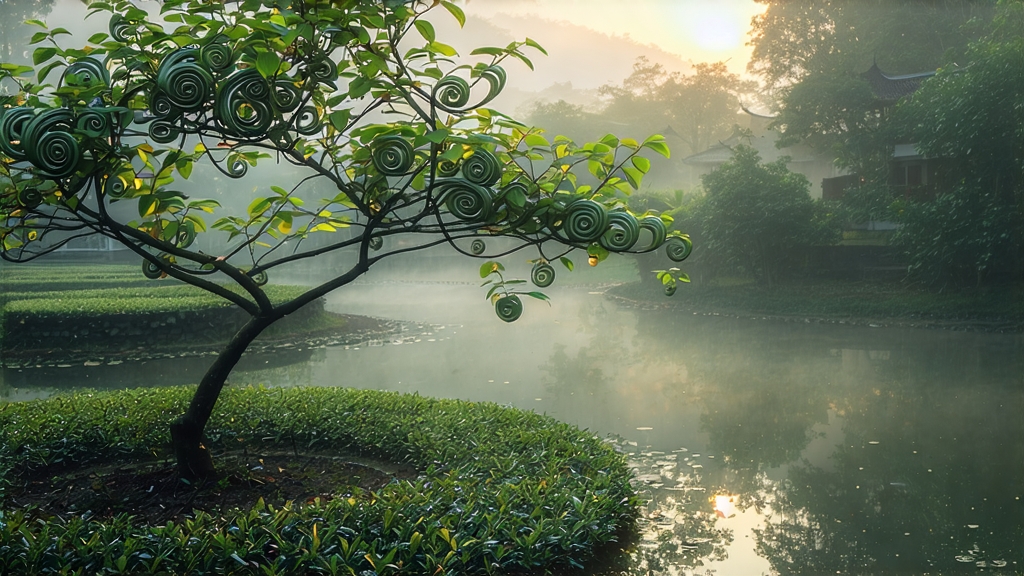
Biluochun, whose name literally means “Green Snail Spring,” is one of China’s ten most celebrated teas, yet it remains a delicate secret outside serious tea circles. Produced only in a narrow strip of hills hugging Taihu Lake in Jiangsu Province, this tea turns the first blush of March into a cup that smells of peach blossoms and tastes like sweet, liquid jade. To understand Biluochun is to listen to a 1,200-year-old conversation between monks, emperors, fruit trees and lake mist; the following pages translate that dialogue for the international tea lover.
History: From Island Tribute to Imperial Romance
The earliest record appears in the Tang dynasty “Tea Canon” of 838 CE, where the monk Zhi-Yu praises “Xia Sha Ren Xiang” (Astounding Fragrance) picked on Dongting Mountain’s east cliff. Local legend says a tea picker, startled by the loud call of a biluo (green snail) in the undergrowth, accidentally packed fresh buds inside her bamboo basket along with falling peach petals; overnight the leaves absorbed the perfume, creating an unprecedented aroma. By the late Ming dynasty the Kangxi Emperor, touring the lower Yangtze, sampled the tea and instantly renamed it Biluochun to honor its spiral shape and spring harvest. Annual tribute quotas were fixed at 9.9 jin (4.95 kg), making genuine Dongting Biluochun rarer than silver. Today the 3,000 hectare core zone is a UNESCO-protected agricultural heritage site, and every kilo of authentic early-spring leaf still requires 70,000 hand-plucked buds.
Micro-Terroir: Lake, Mist and Fruit
Dongting Mountain is actually two islands, Dongshan and Xishan, rising from China’s third-largest freshwater lake. Warm daytime lake vapors meet cool night air, forming a 200-meter fog belt that filters sunlight and forces slow amino-acid accumulation. Around each tea bush grow three canonical fruit trees: peach, plum and loquat. Their simultaneous March bloom showers nectar into the air; the tea leaf’s porous surface adsorbs these molecules, yielding the famous “flowery fruit note” no other green tea possesses. Soils are quartz-sand mixed with shell-rich lake sediment, draining quickly yet retaining trace zinc and selenium that accentuate sweetness.
Cultivars: Seedlings versus Clones
Traditionally Biluochun came from seed-grown “Dongting Qunti” (local population), a genetically diverse mix of small-leaf Camellia sinensis var. sinensis. After 1982 researchers selected the early-sprouting, downy-rich “Dongting 1” clone for higher yield, yet connoisseurs still chase the wilder, more fragrant Qunti leaf. A third cultivar, “Fuding Dabaicha,” is sometimes grafted onto local rootstock to boost amino content, but purists insist only Qunti grown within the 12 officially mapped villages deserves the name.
Harvest Calendar: One Leaf, One Heart
The picking window opens around Grain Rain (April 5–7) in the lunar calendar and closes within twenty days. Standard grade is “one bud just unfolding into a tiny leaf” (qiao-she), while the top grade “tekkō” (iron bud) demands a tight, unopened bud no longer than 2.5 cm and coated in silvery trichomes. Experienced pluckers finish 500 g of fresh leaf in four hours; that same 500 g will shrink to 100 g after firing, enough for only twenty cups.
Craft: The Six-Step Spiral
- Withering: Buds are spread 2 cm thick on bamboo trays set under shade nets for two hours, reducing moisture to 68 % and allowing grassy volatiles to drift away.
- Primary Kill-Green (shaqing): A 200 °C drum roaster halts oxidation in 90 seconds; the operator listens for the “popcorn crackle” that signals leaf cells rupturing.
- Hand-Rubbing: The still-hot leaf is transferred to a straw mat where artisans roll it against the surface in a figure-eight motion for eight minutes, breaking epidermal walls so fruit essences can migrate inward.
- Spiral Shaping: On a 70 °C cast-iron pan the master uses three fingers to press and twist, forming the signature spiral. Each 3-gram coil requires 37 rotations; timing errors create either loose “fish-tail” or over-tightened “dead snail.”